READY TO GET STARTED?
REQUEST A FREE ESTIMATE
Fill out the form below or call (888) 466-7849 for a free, no-obligation estimate.
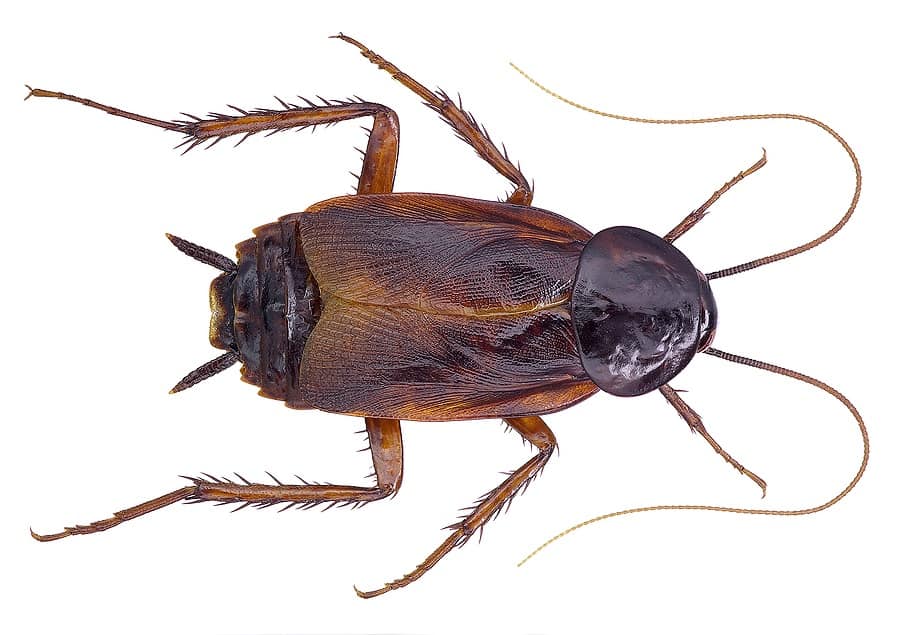
Oriental cockroaches are one of the larger species of roaches. Despite their name, they are thought to have originated in Africa. They are also known as waterbugs (because of their habitats) and black beetle cockroaches (because of their appearance). Like any other roach species, these cockroaches can spread diseases to humans, contaminate surfaces in your home, and trigger allergies and asthma.
Although they are active year-round, oriental roaches are more prevalent in the warmer months. They are often found crawling around toilets, pipes, and sinks. In fact, once indoors they are known to live in rarely used sink drains, garbage disposals, under cabinets with plumbing, and in bathroom voids. Outdoors they are found in flower beds, under mulch, in woodpiles, or anywhere there is moisture. They get into your home under doors, gaps in siding, through pipes, sewers, and drains.
Oriental cockroaches are smooth and shiny black in appearance. They grow to about 1″ in length. Males are smaller than females and have wings. Females are much larger with no wings. Although the males have wings, they are unable to fly.
Once you’ve identified the oriental cockroach, the next question is why are they in your house? Oriental cockroaches are attracted to moisture; in fact, they depend on it for survival. If you’re seeing oriental cockroaches, odds are you have excessive moisture somewhere in your home. This could be a leaky pipe or faucet, leaky roof, moisture-laden crawlspace, clogged gutters, standing water in your yard, overpopulated flowerbeds that hold moisture, etc.
To get rid of these pests, check out these oriental cockroach prevention tips:
If you have a problem with oriental cockroaches or other pests, contact your local pest control company for a thorough evaluation.
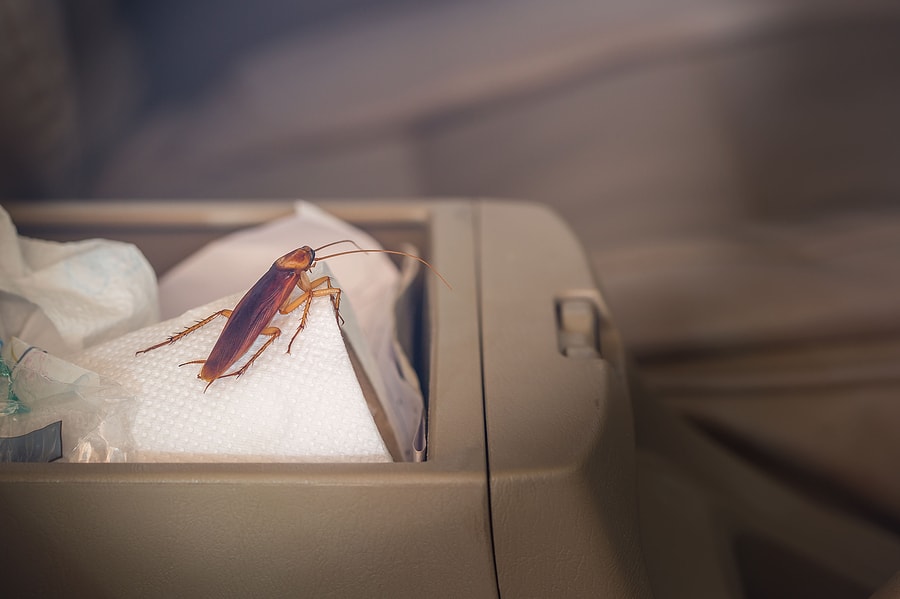
Cockroaches are one of the most common household pests that homeowners have to deal with. These pests are resilient and are known to survive under the harshest conditions. So why do these pests seem so hard to get rid of? What are the best methods to eliminate them from making their way inside your home?
Cockroaches are built to be almost indestructible. Roaches have exoskeletons made up of overlapping plates connected by a stretchy membrane. This membrane is so flexible that it can allow them to fit through small cracks and crevices. Along with their stretchy membrane, they also have a thick outer layer that can protect them and shift when needed.
Since roaches can use their bodies to fit through small areas, they are great at surviving in harsh conditions. Cockroaches will find shelter to avoid harsh temperatures and other predatory pests that threaten them.
While cockroaches are durably built and sneaky, it doesn’t mean that they are impossible to keep from getting inside your home. Consider utilizing these roach prevention tips:
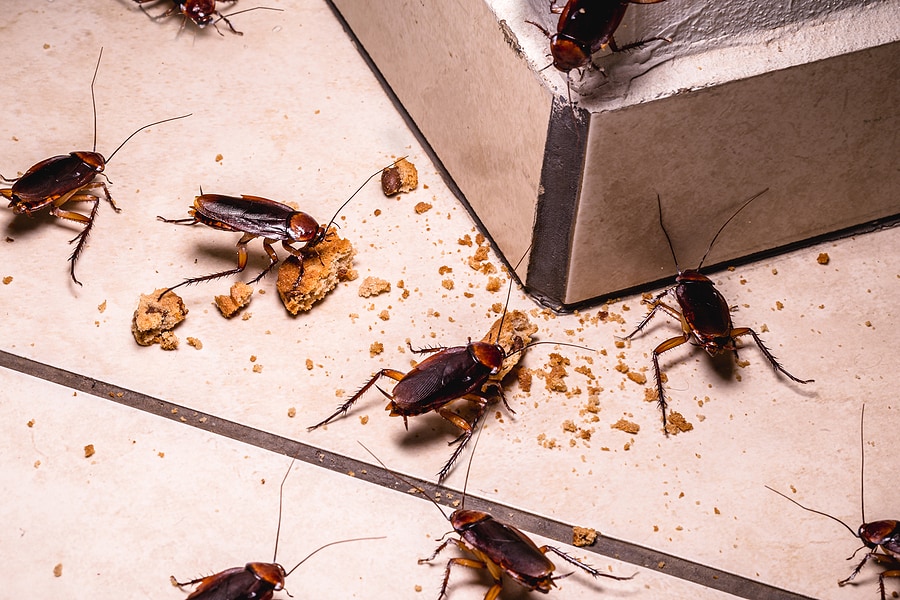
Most people equate cockroaches with dirty homes but this isn’t always the case. What attracts cockroaches to a clean house is food, water, and warmth. While the presence of one cockroach in your home can be enough to send you into a panic, one roach doesn’t necessarily mean you have a full blown infestation. Roaches are social pests, however, and reproduce quickly. If you spot one, odds are there are a few others lurking nearby, in dark corners or cracks and crevices and they could be fast on their way to a full blown infestation.
Cockroaches are dangerous to humans – they carry bacteria on their bodies and their feet, contaminating any surfaces they come into contact with. They can also trigger allergies and asthma. Besides seeing a live bug, how do you know you could have a cockroach problem? Signs of cockroaches in your home include dead bodies; eggs or eggshells (which are small, brown and oval-shaped); droppings (which are dark and powdery like ground coffee); and a strong, musty odor that doesn’t go away.
The best method of roach control is to be proactive in preventing them. Prevent cockroaches by:
Roaches are attracted to dirt and crumbs as a source of food Make sure to always wash dishes after a meal and put them away. Clean up any crumbs and spills immediately. Take out the garbage before going to bed. Clean any grease from your stovetop. Keep food sealed in airtight containers. Sweep, mop, and vacuum on a regular basis. Don’t leave pet food, treats, and water out overnight.
Clearing out clutter gets rid of places roaches can use to hide. Keep rooms clutter free and dusted often. Use plastic storage bins with lockable lids versus cardboard boxes. Eliminate newspapers and cardboard altogether as roaches love to breed in these materials.
Roaches get into homes under doors and through cracks. Identifying these and sealing them up helps eliminate points of entry for cockroaches and other pests. Thoroughly inspect around windows and doors, along foundations and the roof, in attics and crawlspace vents, and around holes used for utility and plumbing lines. For small holes and cracks, use caulk to seal them. For larger holes, especially around pipes, use steel wool and foam to seal. Fine mesh wire can be used to seal around attic vents and chimneys.
Roaches, like most pests, need water and moisture to survive. Therefore, standing water or excessive moisture can attract roaches to your home. Regularly inspect your plumbing for leaks and repair them immediately. Make sure to check faucets, sinks, refrigerators, and appliances for leaks and excessive moisture. Crawlspaces are also a common source of excess moisture in homes. Consider crawlspace enclosure to help minimize moisture under your home.
A cockroach infestation can be extremely difficult to control. Prevention can only go so far in the battle against roaches. If you suspect you have a problem with cockroaches, contact a professional pest control company who can help identify the type of roach you have, thoroughly inspect your home to identify points of entry or food sources, and help set you up with a comprehensive roach control treatment and prevention plan.
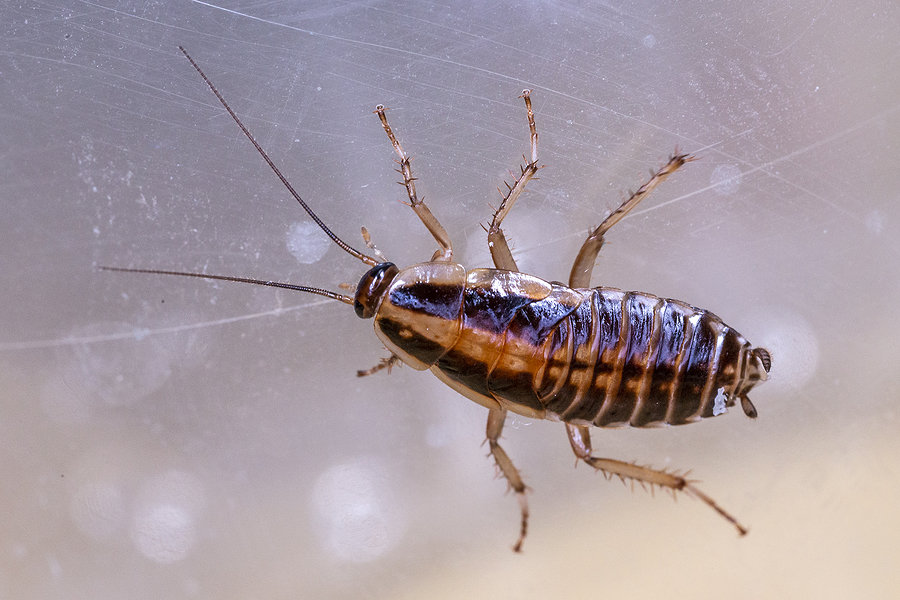
German roaches are the most common species of cockroach worldwide. They can be found infesting just about anywhere that humans occupy. How do you know if you have German cockroaches? What do they look like? Are these roaches dangerous to humans? Get the answers to these questions and more with our 411 on German cockroaches.
German roaches are flat and oval-shaped with 6 legs and a pair of antennae. They are smaller than other species of cockroaches, measuring between 1/2″ and 5/8″ in length. They are light brown to tan in color with 2 dark parallel stripes on their backs, just behind their heads. Females are darker than males. This species has wings but rarely fly; they prefer to run instead.
German cockroaches are an indoor pest, preferring warm, humid environments. They prefer temperatures between 85 and 95 degrees Fahrenheit with 90 to 95% humidity. They make their way indoors by hitchhiking on grocery bags, cardboard boxes, and used appliances. They are often found above refrigerators or other heat producing appliances, under sinks, and around water pipes in kitchens and bathrooms so they can be near food and water sources. They are found throughout the United States.
German roaches will eat almost anything. This includes soap, glue, toothpaste, food crumbs, and bindings of books.
German cockroaches have been linked to disease transmission in humans. As they crawl across fecal matter and other areas, they pick up germs on the spines of their legs and then transfer them to food and other surfaces. It has been proven that German cockroaches spread 33 different bacteria, 6 parasitic worms, and 7 other human pathogens. Their saliva, droppings, and even their dead bodies have proteins that can trigger allergies and increase asthma symptoms, especially in children.
If you spot one German roach in your home, it is highly likely that there are many more hiding in cracks and crevices. Females can lay up to 40 eggs at a time which then mature within about 2 months. The female carries the egg case for up to a month and drops it right before it hatches. They can breed up to 6 generations per year. Adult German roaches can live up to 200 days. This quick reproductive rate combined with their lack of natural predators makes a German cockroach infestation difficult to control.
German cockroaches aggregate in groups when they infest your home. You are likely to find their droppings in areas that they frequent. These droppings appear as small, dark, pepper-like material that is often found on counters and in drawers. Their feces can also stain, leaving dark spots and smears in the corners of rooms, along the tops of doors, and around small cracks and openings in walls. When these roaches infest in large numbers, they can also give off a mild, musty odor.
The first step in preventing a german cockroach infestation is practicing good hygiene. Keep your kitchen and bathroom clean, cleaning up crumbs and spills quickly. Sweep, mop, and vacuum often. Don’t leave any dirty dishes in the sink. Don’t leave pet food and water bowls out overnight. Seal all the openings in the exterior of your home, especially around utility pipes. Ventilate or consider enclosing your crawlspace.
If you suspect you have a cockroach infestation of any species, contact a professional pest control company who can provide you with an in-depth inspection and set you up with an appropriate treatment and prevention plan.
What You Can Expect from Lawn Care Service
What You Need to Know About Millipede Control
Watch out for the Stinging Pests!
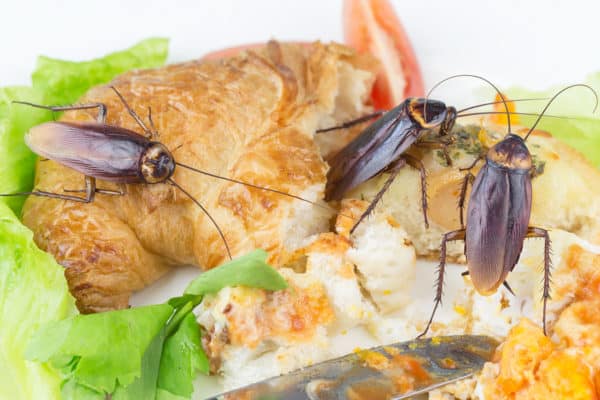
Cockroaches carry many diseases and can cause several health issues in humans including food poisoning and can trigger allergies and asthma attacks. So where do roaches come from?
If you have a roach infestation in your home, there could be several reasons why. Roaches may have already been in your home before you moved in. Roaches are also very good hitchhikers and are easily transported from one place to another. They can get into your home in grocery bags, cardboard boxes, luggage, furniture, or appliances. They can also get in through the plumbing, sewers or drains. They can travel over from your neighbor’s home into yours, too.
But what attracts cockroaches if your house is clean? Like most pests, roaches are looking for three main things: food, shelter, and water. They are year-round pests and are incredibly resilient – making them difficult to control. Different species of cockroaches are attracted to and thrive in different environments.
German cockroaches are the most common indoor roaches. They prefer dark, warm, humid places near food and water, preferably in a temperature range of 70 to 75 degrees Fahrenheit. You can usually find German roaches in kitchens, in cracks and crevices of cabinets, near sinks or appliances, and in food prep and storage areas. They can also be found in bathrooms when the roach infestation is heavy. Early detection and control of german roaches is extremely important as they can be very hard to get rid of.
Oriental roaches prefer dark, damp, cool habitats. Outdoors you can usually find them where there is an abundant supply of organic matter like mulch or wood chips, under patio bricks, or between the soil and your foundation. Once inside your home, they are often found in drains, basements, and crawlspaces. They can also be found near leaky water pipes, under sinks, refrigerators, floors, and washing machines.
Brown-banded roaches prefer warmer, drier places (greater than 80 degrees Fahrenheit). They live in higher areas, usually at eye level or above, like your cabinets, pantries, closet shelves, behind pictures, in books, or under kitchen tables and chairs. They can also be found in warm areas such as near clocks, timers, TVs, and refrigerator motors.
American cockroaches are found in homes, restaurants, bakeries, and grocery stores – anywhere food is prepped and stored. They prefer warm, moist environments and can often be found in boiler rooms, basements, around pipes and water heaters, and in drains and sewers.
Here are some tips to prevent roaches from infesting your home:
Clean up spilled crumbs and food immediately. Don’t leave dirty dishes out overnight. Throw away any food that is left out on the counter. Wipe down the surface of all food prep areas every night. Clean under your appliances and wipe down any that are on your counter. Make sure to clean underneath the refrigerator and stove, also. Rinse out milk jugs, juice cartons, and cans before throwing them away. Empty your garbage can every night and use garbage cans with tight fitting lids. Check kitchen drawers for any food debris and crumbs. Store food in airtight containers. Store pet food in airtight containers and elevate them off the floor. Don’t leave your pet’s food and water bowls out overnight. Roaches communicate through chemical pheromones they secrete as they move. Cardboard and paper are excellent absorbers of these pheromones. Replace cardboard boxes with plastic containers if possible. Don’t bring any cardboard boxes used for storage inside the home. Don’t store piles of newspapers – recycle them instead.
Carefully inspect the interior and exterior of your home. Seal any gaps or crevices you find, even the smallest ones. Roaches can squeeze through the tiniest openings to get into your home. Use weatherstripping around all entryways including doors and windows. Declutter as much as possible. Roaches can also get into your home through drainpipes. Use stoppers or metal baskets on all the drains in your sink and shower and make sure to keep your drains clean. Roaches will also hitch rides on firewood. Make sure to only bring in enough wood for one fire and don’t store any extra wood inside.
Most species of roaches prefer moist areas so eliminating water is key to helping prevent them. Remove any standing water in and around your home. Check for leaks and repair them promptly. Use caulk to seal gaps around your sink and tubs to keep water out of the walls. Don’t let water stand for long periods of time in plants and flowerbeds. Don’t leave your pet’s water bowls out overnight. Hang any wet towels and mats up to dry after using them. Keep your kitchen sponges dry and don’t store them on the counter.
Roaches can be incredibly difficult to control and eliminate. If you have a roach problem, contact a professional pest control company or schedule a free pest inspection now. A pest control technician can thoroughly inspect your home to identify not only where and how roaches are getting into your home, but also the specific type of roaches to better treat and eliminate them.
Why Are There so Many Millipedes in my House?
Is Your Hotel on the Bed Bug Registry?
Lawn Survival Tips for the Summer Heat
What Attracts Cockroaches to a Clean House?
Is Termite Protection Worth It?